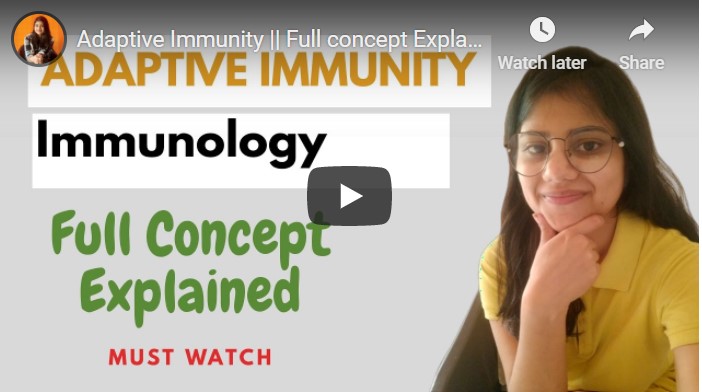Do you ever notice every time you exposed to a disease such as cold or the flu, the infection period for that disease gets shorter for the next time you are exposed to the same disease?
Our adaptive immune system saves us from different infections by remembering the pathogen. It creates the memory of the invaders and prepared the immune system for fighting that pathogen. Any individual having a defective adaptive immune system will die earlier than the person’s healthy adaptive immune system.
In the previous article, we have learned about Innate immunity. As we know the innate immune system is the first line of defense in our body, but what if our innate immune system is not able to deal with the pathogen. In this case, the adaptive immune system came into function. If the innate immune system is not able to deal with the pathogen it tells the adaptive immune system to help and then both deal with the pathogen and keeps us safe. Unlike innate immune system responses, the adaptive responses are vastly precise to the pathogen which induced them. The adaptive immune system provides us long-lasting protection.
What is adaptive immunity?
As the name also defining the meaning of adaptive immunity is to adapt according to the real-time exposure to the pathogen. The main function of the adaptive immune system to execute the invading pathogens and any toxins produced by the pathogens.
For example, suppose a person having measles and he/she recovers from it than our body knows the cause of measles and creates a memory of how to fight and kill that pathogen. For the next time when the pathogen of measles tries to enter again in our body, our body recognizes the invaders and kills that.
Properties of adaptive immunity.
- Adaptive immune responses are carried by WBC (white blood cells) known as lymphocytes. Adaptive immunity relies on B and T lymphocytes. B cells are formed and matured in the bone marrow. B lymphocytes provide humoral immunity and secrets to the soluble proteins known as antibodies. These soluble proteins can be found in blood or extracellular matrix.
- T cells are also formed in bone marrow, but these cells migrate to the thymus and matured there. T lymphocytes provide the cell mediate immunity and comes with the physical contact with the antigen.
- Adaptive immunity is always antigen-specific. An antigen is any substance that can stimulate the immune response.
Many foreign molecules enter our body and they are harmless or can cause less harm such as high fever or asthma, so it would be worthless to mount an adaptive immune system against them because adaptive immune responses are quite destructive. So, these inappropriate responses are avoided normally and if our immune system is unable to differentiate between self and no-self (harmful and harmless cells) then there is a disease known as an autoimmune disorder. In the case of autoimmune disease, our immune systems start killing their cell because it hard for the immune system to distinguish what is self and what is an invader or pathogen.
- Adaptive immunity is slower in comparison to innate immunity this is because it takes time to recognize the antigen and create the memory of its pathogenic proteins. For the next time when we are exposed to the same pathogen, the adaptive immune system responds quickly because it has pre-built memory of that pathogen.
- Adaptive immunity is characterized by the properties of creating memory, specificity, and tolerance.
- Specificity: for every antigen, there are specific receptors are present.
- Memory: Adaptive immunity is fast for pre-exposed antigen as our immune system has a memory created during previous exposure.
- Tolerance: immune cells are not able to react with self-antigen.
Adaptive immunity is a basis for vaccination. The basic principle of the vaccination is to create a memory in our immune system for a specific pathogen.
Differences between innate and adaptive immunity
| Innate immunity | Adaptive immunity |
| Nonspecific | Specific |
| Present in the body by birth | Developed by exposure to external factors |
| Rapid response | Slower, might take 5-6 days |
| Does not develop memory cells | Develops the memory cells |
| The same response each time | More rapid and effective with each exposure |
References :
- 1. Vesely, P. (2004). Molecular biology of the cell. By Bruce Alberts, Alexander Johnson, Julian Lewis, Martin Raff, Keith Roberts, and Peter Walter. ISBN 0‐8153‐3218‐1; hardback; 1,616 pages; $110.00 Garland Science Inc., New York, 2002. Scanning: The Journal of Scanning Microscopies, 26(3), 153-153.
- 2. Kindt, T. J., Goldsby, R. A., Osborne, B. A., & Kuby, J. (2007). Kuby immunology. Macmillan.

Not much of reader but your article kept me interested enough to finish